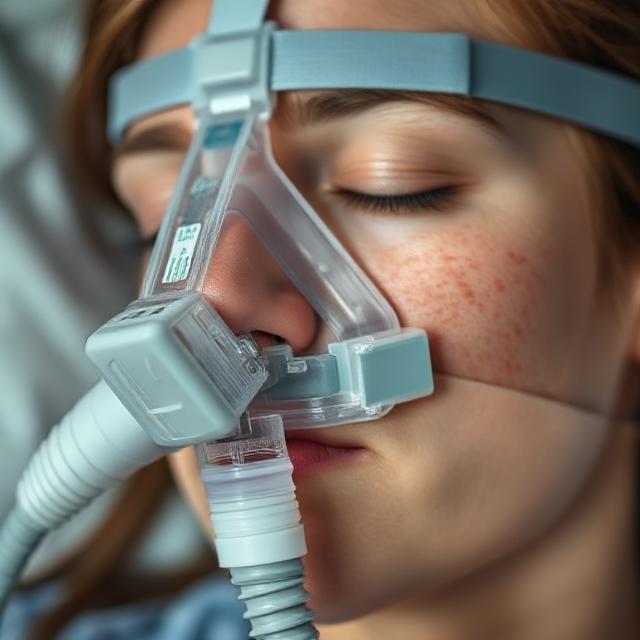Introduction to Nose Sores CPAP
For many individuals living with sleep apnea, Continuous Positive Airway Pressure (CPAP) therapy offers essential relief. Despite its benefits, CPAP users sometimes encounter uncomfortable side effects, particularly Nose Sores CPAP. These sores can range from mild irritation to painful lesions that make therapy challenging. Understanding the causes, symptoms, and solutions for Nose Sores CPAP can help you maintain your treatment plan without unnecessary discomfort.
What Causes Nose Sores CPAP Therapy?
Nose Sores CPAP often develop due to friction, pressure, and moisture associated with wearing a CPAP mask. Here are some of the most common culprits:
1. Poorly Fitted Mask
A CPAP mask that’s too tight or too loose can create uneven pressure points, leading to skin irritation. Masks that don’t seal properly might slide around during use, causing chafing or rubbing.
2. Skin Sensitivity
Some people have sensitive skin that reacts to prolonged contact with the mask material. Silicone, commonly used in CPAP masks, can sometimes irritate the skin, leading to redness and sores.
3. Lack of Hygiene
Failure to regularly clean your CPAP mask and its components can lead to bacterial or fungal buildup. This introduces harmful microbes to your skin, increasing the risk of infections and sores.
4. High Humidity Levels
Cranking up the humidifier attached to your CPAP machine may help prevent a dry nose, but excess moisture can sometimes soften the skin inside your nostrils. Softened skin is more prone to breaking down, resulting in sores.
5. Extended Use
Using CPAP therapy every night for hours is critical for effective treatment. However, the extended wear time can make sensitive areas like the bridge of your nose or the inside of your nostrils more susceptible to irritation.
Common Symptoms of CPAP-Related Nose Sores CPAP
Nose Sores CPAP caused by CPAP therapy may present in several ways. The symptoms can help you identify the issue early, preventing further complications. Pay attention to:
- Redness: Either on the bridge of the nose or inside your nostrils.
- Dryness or Flaking Skin: Often an early warning sign of irritation.
- Pain or Tenderness: Especially in areas that come into contact with the mask.
- Cracks or Open Wounds: Severe irritation can lead to broken skin, which is prone to infection.
- Swelling or Pus: These may indicate an infection and should be addressed immediately with medical treatment.
Effective Solutions for CPAP-Related Nose Sores
Dealing with Nose Sores CPAP doesn’t mean you have to abandon your therapy. Making small adjustments to your routine can make a big difference. Here are some practical solutions:
1. Invest in Proper Mask Fitting
The wrong mask fit is one of the main causes of Nose Sores CPAP. Consult with your healthcare provider or equipment supplier to ensure your mask fits snugly but comfortably. Masks come in various styles, from full-face masks to nasal pillows, so explore different options if your current one isn’t working.
2. Use Nasal Pads or Mask Liners
Soft barriers like nasal pads or mask liners can be placed between your skin and the mask, preventing direct contact and reducing irritation. These accessories are readily available and designed specifically for CPAP users.
3. Maintain Rigorous Hygiene
Clean your mask daily with warm water and mild soap or specialized CPAP cleaning solutions. Regularly washing your face before donning the mask also reduces skin irritation and lowers the chance of infection.
4. Adjust Humidity Settings
If your humidifier setting is too high, it could be adding excess moisture that irritates the skin inside your nose. Experiment with lower humidity levels to find a balance that keeps your nasal passages comfortable but not overly damp.
5. Switch to a Different CPAP Mask Material
If silicone is causing a reaction, you might benefit from masks made of alternative materials like fabric or gel. Some skin types are less likely to react adversely to these options.
6. Apply Skin Protectant
Over-the-counter barrier creams or ointments, such as petroleum jelly, can supplement your skin’s natural barrier. Apply a thin layer to potential trouble spots before putting on your mask. Use non-greasy, CPAP-safe options to avoid damaging the mask seal.
7. Take Mask-Free Breaks
During the day, allow your skin to “breathe” by giving it breaks from the mask. Incorporating recovery time into your routine can prevent sores from worsening.
Preventing Persistent Issues with Professional Advice
Nose Sores CPAP therapy shouldn’t be ignored, particularly if they worsen or don’t resolve with simple remedies. Persistent issues may indicate an underlying problem with your treatment setup or skin health.
When to Seek Medical Attention
- If sores become infected, characterized by redness, swelling, warmth, or pus.
- If the pain disrupts your ability to continue CPAP therapy.
- If over-the-counter remedies and preventive measures fail to resolve the issue.
A healthcare provider or sleep specialist can pinpoint the problem and suggest personalized adjustments, such as switching mask styles or prescribing medicated creams.
Staying Committed to CPAP Therapy
It’s important to remember that Nose Sores CPAP are a manageable side effect of a therapy that can significantly improve your quality of life. Small tweaks to your CPAP routine can relieve discomfort while helping you get the most from your treatment. By prioritizing skin health and collaborating with your healthcare provider, you can overcome the challenge of nose sores and focus on reaping the benefits of restful, uninterrupted sleep.
CPAP therapy is a commitment, but with the right strategies and resources, the hurdles—like Nose Sores CPAP—are far from insurmountable.



